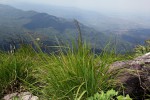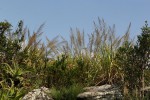| Home | > | List of families | > | Poaceae | > | Eragrostis | > | acraea |
Eragrostis acraea
Selected images: Click on each image to see a larger version and details of the record View all images (11)
Detailed records: Display species records QDS maps by: Google Maps Point records by Google Maps
Species details: Click on each item to see an explanation of that item (Note: opens a new window)
| Synonyms: | |
| Common names: | Broad-leaved love grass (English) Zingae (Manica) |
| Frequency: | |
| Status: | Native |
| Description: |
Densely caespitose perennial without rhizomes or stolons; culms stout, up to 200 cm tall, erect, usually unbranched, glabrous at the nodes, eglandular; basal leaf sheaths glabrous, firmly chartaceous, glossy yellow, terete, eglandular, persistent or decaying into parallel fibres; ligule a line of hairs; leaf laminas 15–40(60) cm × 6–12(15) mm, linear, rigid and pungent, flat (involute on drying), glabrous or sparsely pilose, eglandular.Panicle 15–70 cm long, narrowly oblong-elliptic, rather dense and usually contracted, the spikelets evenly distributed on pedicels 2–6 mm long, the primary branches 1–several at a node but scarcely whorled, terminating in a fertile spikelet, glabrous in the axils, eglandular.Spikelets 3–7 × 2–2.5 mm, oblong to lanceolate-oblong, laterally compressed, 5–7(12)-flowered, the florets disarticulating from below upwards, the rhachilla persistent; glumes unequal, keeled, narrowly lanceolate in profile, densely scaberulous all over, acute at the apex, the inferior 1–1.5 mm long, reaching to c. 2/3 the way along the adjacent lemma, the superior 1.6–2(2.3) mm long, reaching to about the middle of the adjacent lemma; lemmas 2.3–2.8 mm long, keeled, narrowly elliptic to lanceolate-elliptic in profile, firmly membranous with somewhat indistinct lateral nerves, diverging from the rhachilla at 45°, those in opposite rows not imbricate, the rhachilla visible between them, greyish-green, densely scaberulous all over, subacute to acute at the apex; palea deciduous with or soon after the lemma, scaberulous on the flanks, the keels slender, wingless, scabrid; anthers 3, 1.3–1.5 mm long.Caryopsis 0.7–1 mm long, oblong-elliptic, dorsally grooved. |
| Type location: |
Zimbabwe |
| Notes: | A densely tufted grass. Culms stout, up to 2m. Leaves linear, stiff and sharp-tipped, up to 60 cm long. Inflorescence a long dense panicle; branches normally not whorled. Spikelets lanceolate-oblong, laterally compressed. |
| Derivation of specific name: | |
| Habitat: | In submontane grassland, often abundant as a pioneer in disturbed granite sands. |
| Altitude range: (metres) | 1020 - 2000 m |
| Flowering time: | |
| Worldwide distribution: | Zimbabwe, adjacent areas in Mozambique and Mpumalanga South Africa. |
| National distribution: | MS |
| Growth form(s): | |
| Endemic status: | |
| Red data list status: | |
| Insects associated with this species: | |
| Spot characters: | Display spot characters for this species |
| Images last updated: | Saturday 30 July 2016 |
| Literature: |
Chapano, C. & Mamuto, M. (2003). Plants of the Chimanimani District National Herbarium and Botanic Garden, Zimbabwe Page 24. Chapano, C. & Mugarisanwa, N.H. (2003). Plants of the Matobo District National Herbarium and Botanic Garden, Zimbabwe Page 15. Cope, T.A. (1999). Poaceae Flora Zambesiaca 10(2) Pages 110 - 111. (Includes a picture). Mapaura, A. & Timberlake, J. (eds) (2004). A checklist of Zimbabwean vascular plants Southern African Botanical Diversity Network Report No. 33 Sabonet, Pretoria and Harare Page 103. Poilecot, P. (2007). Eragrostis species of Zimbabwe Éditions Quae,Versailles, France Pages 130 - 131. (Includes a picture). Wursten, B., Timberlake, J. & Darbyshire, I. (2017). The Chimanimani Mountains: an updated checklist. Kirkia 19(1) Page 85. |
Other sources of information about Eragrostis acraea:
Our websites:
Flora of Zimbabwe: Eragrostis acraeaExternal websites:
African Plants: A Photo Guide (Senckenberg): Eragrostis acraeaAfrican Plant Database: Eragrostis acraea
BHL (Biodiversity Heritage Library): Eragrostis acraea
EOL (Encyclopedia of Life): Eragrostis acraea
GBIF (Global Biodiversity Information Facility): Eragrostis acraea
Google: Web - Images - Scholar
iNaturalist: Eragrostis acraea
IPNI (International Plant Names Index): Eragrostis acraea
JSTOR Plant Science: Eragrostis acraea
Mansfeld World Database of Agricultural and Horticultural Crops: Eragrostis acraea
Plants of the World Online: Eragrostis acraea
Tropicos: Eragrostis acraea
Wikipedia: Eragrostis acraea
| Home | > | List of families | > | Poaceae | > | Eragrostis | > | acraea |


